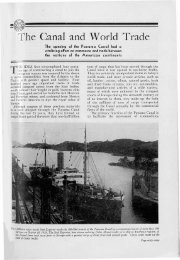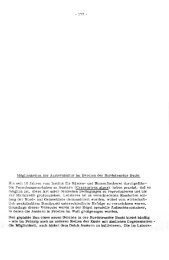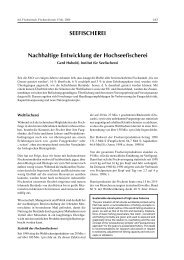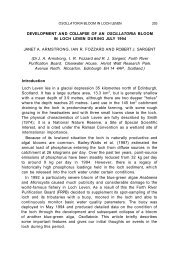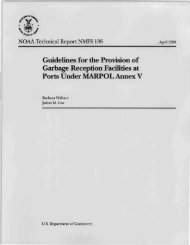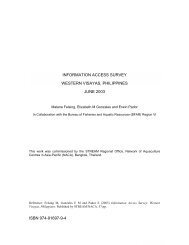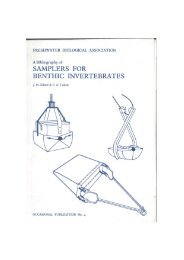The Economic Importance Of Marine Angler Expenditures In
The Economic Importance Of Marine Angler Expenditures In
The Economic Importance Of Marine Angler Expenditures In
Create successful ePaper yourself
Turn your PDF publications into a flip-book with our unique Google optimized e-Paper software.
Abstract—<strong>In</strong> 1998, the National <strong>Marine</strong><br />
Fisheries Service (NMFS) began a series of<br />
marine angler expenditure surveys in the<br />
coastal regions of the United States (U.S.)<br />
to evaluate marine recreational fishing<br />
expenditures and the financial impacts<br />
of these expenditures in each region and<br />
the U.S. as a whole. <strong>In</strong> this report, we<br />
use the previously estimated expenditure<br />
estimates to assess the total financial impact<br />
of anglers’ saltwater expenditures.<br />
Estimates are provided for sales, income,<br />
employment, and tax impacts for each<br />
coastal state in the U.S. Aggregate estimates<br />
are also provided for the entire<br />
U.S., excluding Alaska, Hawaii, and Texas.<br />
Direct, indirect, and induced effects<br />
associated with resident and non-resident<br />
angler expenditures were estimated using<br />
a regional input-output modeling system<br />
called IMPLAN Pro. Nationwide, recreational<br />
saltwater fishing generated over<br />
$30.5 billion in sales in 2000, nearly $12.0<br />
billion in income, and supported nearly<br />
350,000 jobs. Approximately 89 cents of<br />
every dollar spent by saltwater anglers was<br />
estimated to remain within the U.S. economy.<br />
At the state level, many of the goods<br />
anglers purchased were imports, and, as<br />
such, as little as 44 cents of every dollar<br />
stayed in Rhode Island and as much as 80<br />
cents of every dollar stayed in Georgia. <strong>In</strong><br />
the Northeast, the highest impacts were<br />
generated in New Jersey, even though<br />
recreational fishing expenditures in Massachusetts<br />
and Maryland were considerably<br />
higher. <strong>In</strong> the Southeast, the highest<br />
impacts were generated in Florida, and on<br />
the Pacific Coast, the highest impacts were<br />
generated in California. <strong>Expenditures</strong> on<br />
boat maintenance/expenses generated<br />
more impacts than any other expenditure<br />
category in the U.S. <strong>Expenditures</strong> on rods<br />
and reels was the single most important<br />
expense category in terms of generating<br />
impacts in most of the Northeast states.<br />
<strong>Expenditures</strong> on boat expenses generated<br />
the highest in most Southeast states, and<br />
expenditures for boat accessories produced<br />
the highest impacts in most Pacific<br />
Coast states.<br />
<strong>The</strong> <strong>Economic</strong> <strong>Importance</strong> of<br />
<strong>Marine</strong> <strong>Angler</strong> <strong>Expenditures</strong><br />
in the United States<br />
Scott Steinback<br />
Social Sciences Branch<br />
Northeast Fisheries Science Center, NMFS<br />
166 Water Street<br />
Woods Hole, MA 02543-1026<br />
Brad Gentner<br />
Jeremy Castle<br />
Fisheries Statistics and <strong>Economic</strong>s Division<br />
<strong>Of</strong>fice of Science and Technology, NMFS<br />
1315 East West Highway<br />
Silver Spring, MD 20910<br />
e-mail (for Brad Gentner): brad.gentner@noaa.gov<br />
<strong>In</strong>troduction<br />
Saltwater anglers spent a total of $4.2<br />
billion in 1998 on marine recreational<br />
fishing activities in the Northeast Region<br />
(NE) of the United States (U.S.)<br />
(Steinback and Gentner, 2001), $12.5<br />
billion in 1999 in the Southeast Region<br />
(SE) (Gentner, Price, and Steinback,<br />
2001a), and $4.5 billion in 2000<br />
in the Pacific Region (PAC) (Gentner,<br />
Price, and Steinback, (2001b) for<br />
expenditures totaling over $22.6 billion<br />
in 2000 for the U.S. 1 (excluding<br />
Texas, Alaska, and Hawaii which did<br />
not participate in the survey). <strong>The</strong>se<br />
expenditures provided considerable<br />
incomes and employment in a wide<br />
range of manufacturing, transportation,<br />
and service sectors; from retail<br />
and service establishments furnishing<br />
goods and services to saltwater<br />
anglers, to manufacturing and transportation<br />
firms supplying the affected<br />
industries. <strong>The</strong> effects of these expenditures<br />
can be classified as: (1) direct,<br />
(2) indirect, or (3) induced. Direct effects<br />
occur when anglers spend money<br />
at retail and service oriented fishing<br />
businesses (e.g., purchases of ice at<br />
convenience stores or access fees paid<br />
1<br />
to owners of for-hire vessels). <strong>In</strong>direct<br />
effects occur when retail and service<br />
sectors purchase fishing supplies from<br />
wholesale trade businesses and manufacturers,<br />
and pay operating expenditures<br />
(e.g., the retailer purchases<br />
fishing rods from the manufacturer<br />
or wholesaler and pays electric bills).<br />
<strong>The</strong>se secondary industries, in turn,<br />
purchase additional supplies and this<br />
cycle of industry-to-industry purchasing<br />
continues until all indirect effects<br />
are derived from outside the region of<br />
interest. Payments for goods and services<br />
produced outside the study area<br />
are excluded because these effects<br />
impact businesses located in other<br />
regions. <strong>In</strong>duced effects occur when<br />
employees in the direct and indirect<br />
sectors make purchases from retailers<br />
and service establishments in the<br />
1 <strong>The</strong> expenditure surveys did not allow attribution<br />
of non-resident durable expenditures<br />
to any particular state. As a result, non-resident<br />
durable expenditures were not included<br />
in the regional totals. However, when calculating<br />
U.S. totals, all expenditures could<br />
be attributed to the U.S. region, therefore<br />
the U.S. total presented here is greater than<br />
the sum of the regional totals. <strong>The</strong> consumer<br />
price index was used to adjust 1998 and 1999<br />
expenditures into year 2000 dollars.



